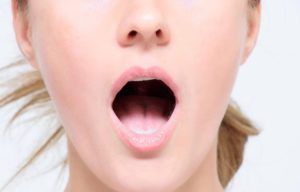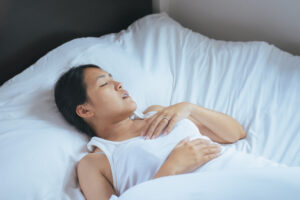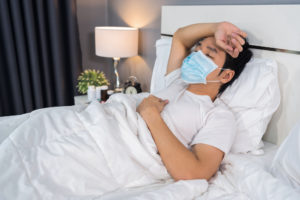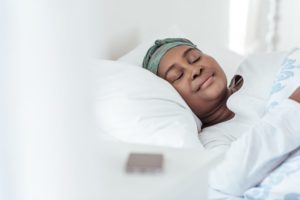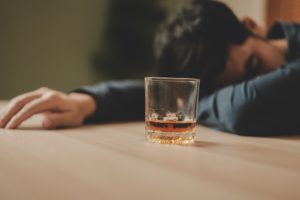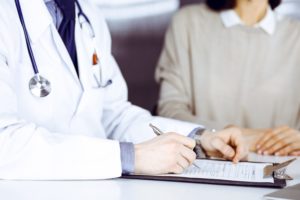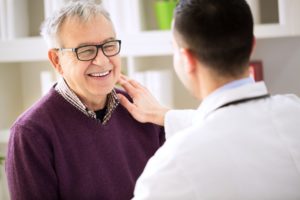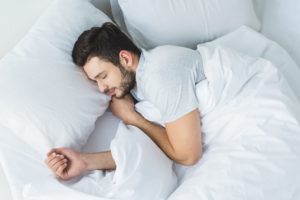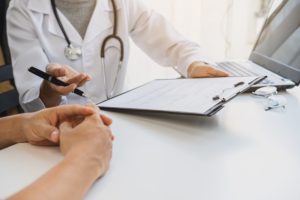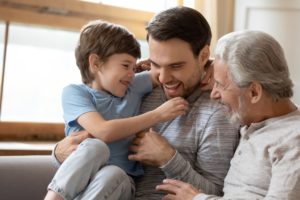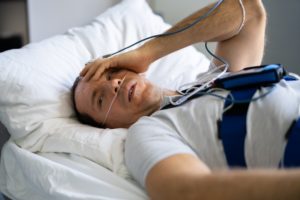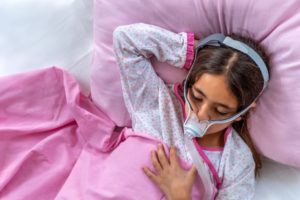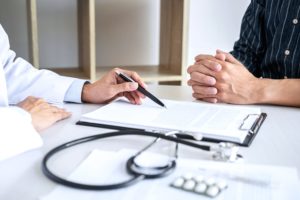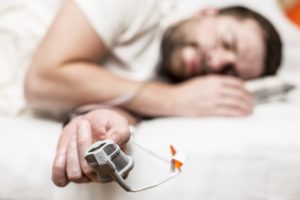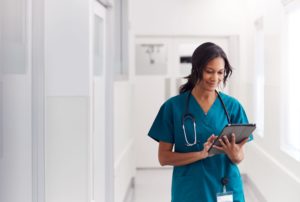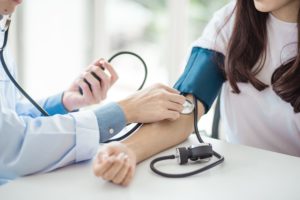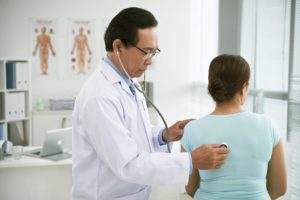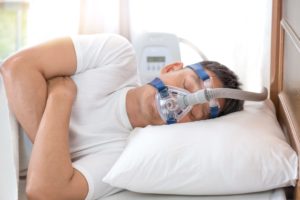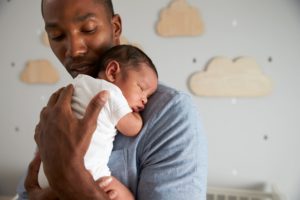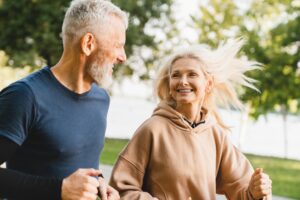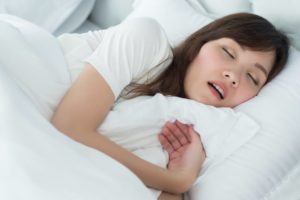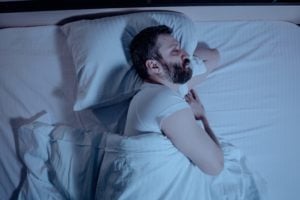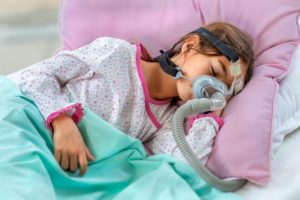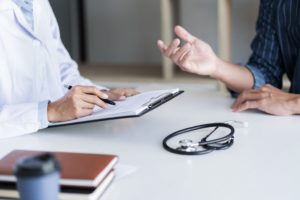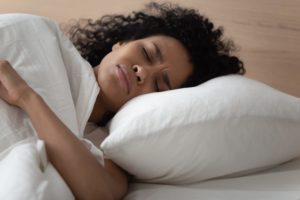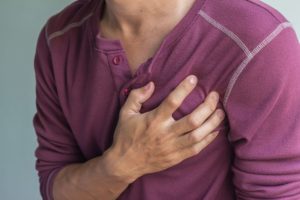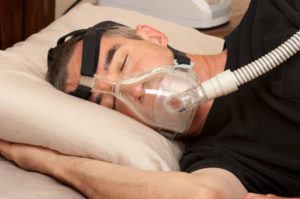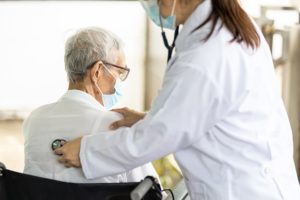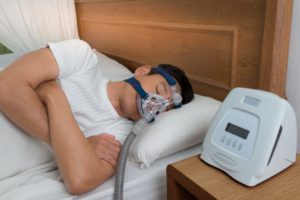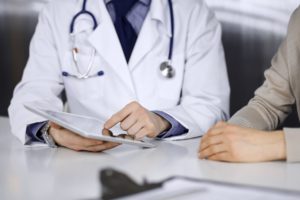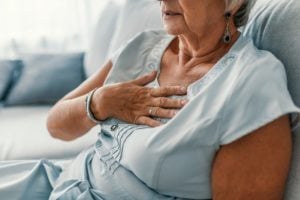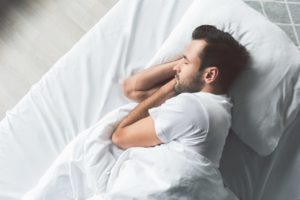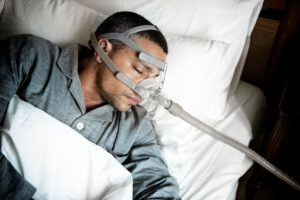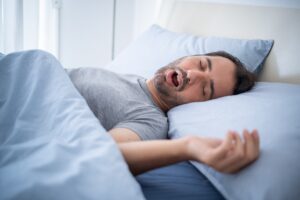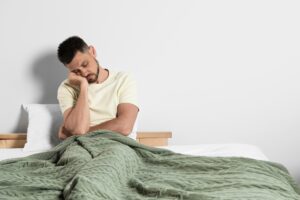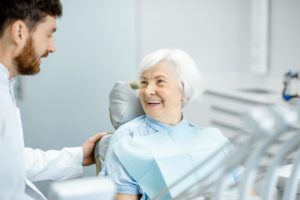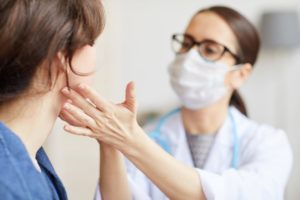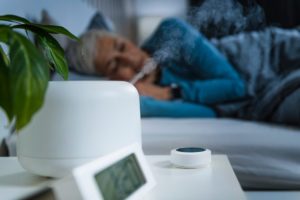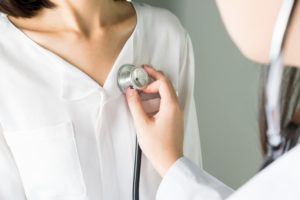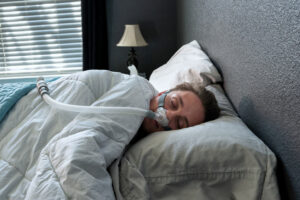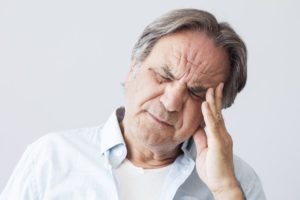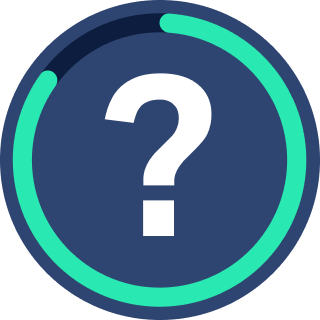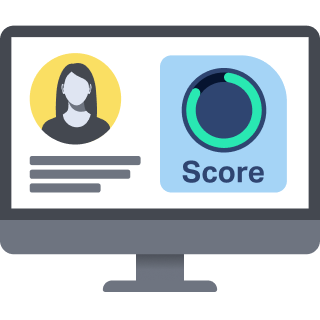Sleep Apnea Symptoms
Sleep apnea is a sleep-related breathing disorder that affects millions of people in the United States. Although some people with sleep apnea experience loud and frequent snoring that catches the attention of a family member or bed partner, many others are unaware of their symptoms and remain undiagnosed.
Sleep apnea causes periods of reduced or paused breathing. Because these symptoms occur during sleep, many people do not realize that nighttime breathing issues are causing them to toss and turn, feel sleepy during the day, and experience a range of other symptoms that can negatively affect their quality of life.
What Are the Symptoms of Sleep Apnea?
Sleep apnea is associated with a wide variety of symptoms, which can vary based on factors like the condition’s severity and the underlying cause of abnormal breathing.
The most common form of sleep apnea is obstructive sleep apnea (OSA), which causes symptoms when the upper airway narrows or collapses during sleep. The less common form, called central sleep apnea (CSA), happens when there is an interruption in the signals from the brain that trigger breathing. The majority of people with sleep apnea experience both central and obstructive breathing issues.
People with sleep apnea can be asymptomatic or not recognize their symptoms until told by a doctor, caregiver, or someone who shares the same bedroom. When symptoms occur, they may include both nighttime signs of abnormal breathing and disruptions to daily living.
Snoring, Gasping, and Pauses in Breathing During Sleep
Snoring is one of the most recognizable symptoms of sleep apnea. This symptom occurs due to a narrowing or collapse of the upper airway. In obstructive sleep apnea, this is due to a combination of an individual’s anatomy and natural changes in the body that happen during sleep, which increase the risk of the tissues collapsing. The sound of snoring occurs when breathing causes these tissues to vibrate.
As many as 90% of people with OSA snore during sleep. Although snoring is a common symptom of OSA, not everyone who snores has sleep apnea. In fact, fewer than half of people who snore meet the criteria for obstructive sleep apnea. Snoring is less common in people with central sleep apnea.
As a person with sleep apnea is resting, a bed partner may notice brief lapses in their breathing that last from several seconds to minutes . This pause in respiration causes the sleeper to wake up . As they awaken and resume breathing, they may sound as if they are gasping, snorting, or choking. People with CSA may also wake up with shortness of breath.
Irregular Breathing
Certain types of central sleep apnea are associated with other abnormal breathing patterns. For example, people diagnosed with CSA with Cheyne-Stokes breathing have periods of rapid breathing that alternate with reductions or pauses in breathing. In this case, a caregiver or bed partner may notice that the sleepers’ breathing appears unstable or erratic with cycles of abnormal breathing that last from 30 seconds to 2 minutes.
Frequent Awakenings and Insomnia
People with sleep apnea are often unaware of the repeated nighttime awakenings that occur each time they wake up to resume breathing. These disruptions in sleep may cause them to toss and turn restlessly throughout the night and wake up feeling unrefreshed.
People with sleep apnea may mistake their condition for insomnia, a sleep disorder characterized by difficulty falling asleep, remaining asleep, or waking up on time. People with sleep apnea may believe that they have insomnia because they wake up often at night. As many as one-third of people with obstructive sleep apnea report symptoms of insomnia.
Nighttime Urination
Also called nocturia, nighttime urination describes waking up at night feeling the need to urinate . Getting up to use the bathroom at least twice each night is a common symptom of sleep apnea, affecting nearly half of people with obstructive sleep apnea.
Normally, the production of urine decreases at night, which allows people to sleep without having to go to the bathroom. In people with OSA, urine production is affected by breathing disruptions that alter pressure within the chest and reduce oxygen levels in the blood. Researchers believe that these changes trigger the release of a hormone that acts as a diuretic and increases nighttime urine output.
Morning Headaches
Headaches after waking up are a frequently reported symptom in people with both obstructive and central sleep apnea. Around 10% to 30% of people with OSA experience headaches, which may last for several hours each morning.
Headaches may feel like both sides of the forehead are being squeezed. Unlike other types of headaches though, morning headaches related to sleep apnea do not usually involve nausea or sensitivity to light or noise.
Researchers are still uncovering the exact cause of morning headaches. Waking up with a headache may be related to the effects of interrupted sleep, pressure building in the skull, or cardiovascular changes caused by breathing disruptions.
Dry Mouth and Sore Throat
People with sleep apnea may also wake up with a dry mouth or throat. Although estimates vary, one-third or more of people with obstructive sleep apnea experience symptoms like oral dryness , burning in the mouth, sore throat, difficulty swallowing, or changes in taste.
Dry mouth can be caused by snoring or breathing with an open mouth during sleep. Dry mouth may be an important sign of OSA, as research has found that the severity of morning dry mouth may be linked to the severity of a person’s nighttime breathing disruptions.
Daytime Sleepiness
Daytime sleepiness is frequently reported in people with both obstructive sleep apnea and central sleep apnea. Sleepiness may occur throughout the day or be more noticeable during monotonous activities such as watching TV or driving long distances.
Excessive daytime tiredness affects between 40% and 58% of people with OSA, depending on the severity of their condition. It is also common for people with CSA to feel overly sleepy during the day. Unfortunately, this symptom is commonly overlooked, as daytime sleepiness increases gradually over time, people may mask their tiredness with activity or caffeine, or people may believe that their level of sleepiness is normal.
In people with sleep apnea, excessive daytime sleepiness is believed to be caused by not getting enough sleep and repeatedly waking up to breathe. Experts suggest that repeated drops in the level of oxygen in the blood and co-existing health conditions may also contribute to daytime sleepiness in people with sleep apnea.
Cognitive and Mood Changes
Sleep apnea can affect a person’s mental health. People with sleep apnea may notice changes in their memory as well as their ability to concentrate and maintain attention. Sleep apnea is also associated with mood changes like increased impatience and irritability. People with sleep apnea may also be at an increased risk of certain mental health conditions like depressive disorders, anxiety disorders, and post-traumatic stress disorder.
Although the connection between sleep apnea and mood is not fully understood, cognitive and mood changes may be a side effect of poor quality sleep. Other factors that may contribute to mood changes in sleep apnea include reduced oxygen in the blood, inflammation, and alterations in brain chemicals.
Loss of Sex Drive and Sexual Dysfunction
People with sleep apnea may have a decrease in their libido or experience issues that affect their sexual performance. Research shows that obstructive sleep apnea is associated with an increased risk of both erectile dysfunction and female sexual dysfunction.
As many as 48% of people with severe OSA experience erectile dysfunction. In males, OSA is associated with reduced testosterone levels, which can affect their sexual health. Although studies related to the impact of OSA on female sexual function are less common, OSA may increase the risk of pain , decreased sexual desire, and challenges with arousal and orgasm in women and people with a vagina.
Sexual function is complex and involves both a person’s psychology and physical processes within their nervous, endocrine, and cardiovascular systems. Sleep apnea may cause changes in sexual function due to the effect of interrupted sleep and fluctuating oxygen levels on one or more of these areas.
Other Symptoms of Sleep Apnea
Other symptoms may be caused by complications of sleep apnea or underlying medical conditions that contribute to nighttime breathing disruptions. Other signs or symptoms of sleep apnea include:
- Nighttime chest pain
- Heart palpitations
- Shortness of breath during physical activity
- Breathlessness when lying down
Take Our Quiz to Know Your Sleep Apnea Risk
Do any of these symptoms sound familiar? We encourage you to take our short quiz below to understand whether you may have sleep apnea.
Symptoms of Sleep Apnea in Children
Sleep apnea can also affect infants and children and may cause unique symptoms in this age group. Although sleep apnea is less common in younger people, experts estimate that from 1% to 5% of children have obstructive sleep apnea and even fewer have central sleep apnea.
Many symptoms of sleep apnea in children are similar to the symptoms seen in adults, such as snoring or gasping, restless sleep, and visible changes in breathing patterns. Children may also experience daytime sleepiness, morning headaches, and changes in mood.
Given that young children may be limited in their ability to describe their symptoms, some symptoms of sleep apnea may appear differently in children. Caregivers may find it helpful to watch out for symptoms of abnormal nighttime breathing such as:
- Sweating at night
- Sleepwalking
- Night terrors
- Falling asleep at school
- Difficulty paying attention
- Bedwetting
- Overactivity
- Rebellious, aggressive, or impulsive behavior
- Worsening asthma
Obstructive Sleep Apnea vs. Central Sleep Apnea Symptoms
Although obstructive sleep apnea and central sleep apnea are different medical conditions, both are characterized by abnormal nighttime breathing that can interrupt sleep and affect oxygen levels in the blood. Doctors cannot tell the difference between these sleep-related breathing disorders based on a person’s symptoms alone.
Because the symptoms of these conditions are similar, doctors use the results of a sleep study to differentiate between obstructive and central sleep apnea . Also called polysomnography, a sleep study takes various measurements while a person sleeps through the night in a specialized sleep laboratory.
To distinguish between obstructive and central sleep apneas, doctors consider several factors including measurements that assess whether a person is attempting to breathe during a period of reduced or paused respiration.
If tests show that a person is trying to breathe against a closed or obstructed airway, they may be diagnosed with OSA . Conversely, if tests show that they stop trying two breathe during periods of disrupted breathing, they may be diagnosed with CSA. Because many people experience aspects of both obstructive and central sleep apnea, a doctor will consider whether most breathing disruptions are obstructive or central in origin.
When to Talk to Your Doctor About Sleep Apnea
If you experience persistent daytime sleepiness or other symptoms of sleep apnea, it is important to contact your doctor or a sleep specialist. While untreated sleep apnea can contribute to a myriad of complications, sleep apnea treatment may reduce symptoms and improve your sleep.
Several tips may help you figure out the cause of your symptoms and get the most out of working with your doctor.
- Keep a sleep diary: Keeping a daily record can help your doctor get the clearest picture of your symptoms. A sleep diary should include information about your sleep habits as well as both nighttime and daytime symptoms.
- Assess caffeine use: Some people use coffee or energy drinks to cover up daytime sleepiness caused by nighttime breathing disruptions. Be sure to tell your doctor if you find yourself drinking excessive caffeine or using caffeine to prevent yourself from falling asleep during daytime activities.
- Ask your bed partner: Because many of the symptoms of sleep apnea occur during sleep, people who share your room or otherwise see you sleep are important sources of information. If you are concerned about sleep apnea, ask bed partners, caregivers, and loved ones about your nighttime breathing.
Medical Disclaimer: The content on this page should not be taken as medical advice or used as a recommendation for any specific treatment or medication. Always consult your doctor before taking a new medication or changing your current treatment.
References
19 Sources
-
Badr, M. S. (2022, April 15). Pathophysiology of upper airway obstruction in obstructive sleep apnea in adults. In N. Collop (Ed.). UpToDate., Retrieved September 27, 2022, from
https://www.uptodate.com/contents/pathophysiology-of-upper-airway-obstruction-in-obstructive-sleep-apnea-in-adults -
National Institute of Health Office of Communications and Public Liaison. (2017, July). Struggling to sleep? Don’t let apnea steal your sweet dreams., Retrieved September 27, 2022, from
https://newsinhealth.nih.gov/2017/07/struggling-sleep -
Badr, M. S. (2021, April 15). Central sleep apnea: Pathogenesis. In R. D. Chervin (Ed.). UpToDate., Retrieved September 27, 2022, from
https://www.uptodate.com/contents/central-sleep-apnea-pathogenesis -
Johnson, T. M. (2022, September 20). Nocturia: Clinical presentation, evaluation, and management in adults. In M. P. O’Leary (Ed.). UpToDate., Retrieved September 27, 2022, from
https://www.uptodate.com/contents/nocturia-clinical-presentation-evaluation-and-management-in-adults -
Maeda, T., Fukunaga, K., Nagata, H., Haraguchi, M., Kikuchi, E., Miyajima, A., Yamasawa, W., Shirahama, R., Narita, M., Betsuyaku, T., Asano, K., & Oya, M. (2016). Obstructive sleep apnea syndrome should be considered as a cause of nocturia in younger patients without other voiding symptoms. Canadian Urological Association Journal, 10(7-8), E241–E245.
https://pubmed.ncbi.nlm.nih.gov/28255415/ -
Raheem, O. A., Orosco, R. K., Davidson, T. M., & Lakin, C. (2014). Clinical predictors of nocturia in the sleep apnea population. Urology Annals, 6(1), 31–35.
https://pubmed.ncbi.nlm.nih.gov/24669119/ -
Pico-Orozco, J., Carrasco-Llatas, M., Silvestre, F. J., & Silvestre-Rangil, J. (2020). Xerostomia in patients with sleep apnea-hypopnea syndrome: A prospective case-control study. Journal of Clinical and Experimental Dentistry, 12(8), e708–e712.
https://pubmed.ncbi.nlm.nih.gov/32913565/ -
Talha, B., & Swarnkar, S. A. (2022, May 21). Xerostomia. In StatPearls. StatPearls Publishing., Retrieved September 27, 2022, from
https://www.ncbi.nlm.nih.gov/books/NBK545287/ -
Zhang, C., Shen, Y., Liping, F., Ma, J., & Wang, G. F. (2021). The role of dry mouth in screening sleep apnea. Postgraduate Medical Journal, 97(1147), 294–298.
https://pubmed.ncbi.nlm.nih.gov/32913036/ -
Lal, C., Weaver, T. E., Bae, C. J., & Strohl, K. P. (2021). Excessive daytime sleepiness in obstructive sleep apnea: Mechanisms and clinical management. Annals of the American Thoracic Society, 18(5), 757–768.
https://pubmed.ncbi.nlm.nih.gov/33621163/ -
Chervin, R. D. (2021, September 29). Approach to the patient with excessive daytime sleepiness. In T. E. Scammell (Ed.). UpToDate., Retrieved September 27, 2022, from
https://www.uptodate.com/contents/approach-to-the-patient-with-excessive-daytime-sleepiness -
Kim, J. Y., Ko, I., & Kim, D. K. (2019). Association of obstructive sleep apnea with the risk of affective disorders. JAMA Otolaryngology, 145(11), 1020–1026.
https://pubmed.ncbi.nlm.nih.gov/31513273/ -
Zheng, D., Xu, Y., You, S., Hackett, M. L., Woodman, R. J., Li, Q., Woodward, M., Loffler, K. A., Rodgers, A., Drager, L. F., Lorenzi-Filho, G., Wang, X., Quan, W. W., Tripathi, M., Mediano, O., Ou, Q., Chen, R., Liu, Z., Zhang, X., Luo, Y., … Anderson, C. S. (2019). Effects of continuous positive airway pressure on depression and anxiety symptoms in patients with obstructive sleep apnoea: Results from the sleep apnoea cardiovascular endpoint randomised trial and meta-analysis. EClinicalMedicine, 11, 89–96.
https://pubmed.ncbi.nlm.nih.gov/31312807/ -
Liu, L., Kang, R., Zhao, S., Zhang, T., Zhu, W., Li, E., Li, F., Wan, S., & Zhao, Z. (2015). Sexual dysfunction in patients with obstructive sleep apnea: A systematic review and meta-analysis. The Journal of Sexual Medicine, 12(10), 1992–2003.
https://pubmed.ncbi.nlm.nih.gov/26395783/ -
Conn, A. & Hodges, K. R. (2021, March). Overview of female sexual function and dysfunction. Merck Manual Professional Version., Retrieved September 27, 2022, from
https://www.merckmanuals.com/professional/gynecology-and-obstetrics/sexual-dysfunction-in-women/overview-of-female-sexual-function-and-dysfunction -
Paruthi, S. (2022, April 15). Evaluation of suspected obstructive sleep apnea in children. In L. Wilkie (Ed.). UpToDate., Retrieved September 27, 2022, from
https://www.uptodate.com/contents/evaluation-of-suspected-obstructive-sleep-apnea-in-children -
Auckley, D. (2021, June 24). Sleep disorders in hospitalized adults: Evaluation and management. In R. Benca & N. Collop (Eds.). UpToDate., Retrieved September 27, 2022, from
https://www.uptodate.com/contents/sleep-disorders-in-hospitalized-adults-evaluation-and-management -
Akbarian, S., Montazeri Ghahjaverestan, N., Yadollahi, A., & Taati, B. (2020). Distinguishing obstructive versus central apneas in infrared video of sleep using deep learning: Validation study. Journal of Medical Internet Research, 22(5), e17252.
https://pubmed.ncbi.nlm.nih.gov/32441656/ -
Schulman, D. (2022, January 12). Polysomnography in the evaluation of sleep-disordered breathing in adults. In S. M. Harding (Ed.). UpToDate., Retrieved September 27, 2022, from
https://www.uptodate.com/contents/polysomnography-in-the-evaluation-of-sleep-disordered-breathing-in-adults


